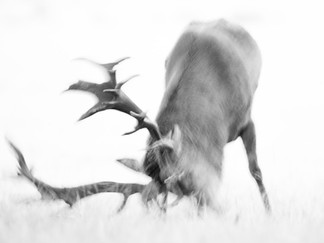Following on from last month's set of low-key photos from the autumn deer rut, this time around I'm sharing - you guessed it - photos in high-key style.

High-key photography is where the image is brightly exposed, often in high-contrast, which creates a striking and eye-catching image. As opposed to low-key, which creates a more withdrawn, introspective portrait. I have a long-running project of high-key images, which I call On White, for lack of a more imaginative name. However over recent years my taste has evolved, and I don't necessarily insist the background has to be pure white for these images. The photo above isn't a pure white background, by choice, as I prefer the slightly reduced contrast. But it's still a high-key portrait. As is the next photo, which doesn't qualify for my On White project, but it's still in the high-key style.

Roaring Portraits
One of my favourite times to capture red deer portraits are when they're 'bellowing', or 'roaring'. It's such a strange noise - somewhere between a cow and a wolf. And it's an iconic posture for red deer.

During the rut they go mad for roaring, often under a tree, which adds depth and echo to their call. I like to try and catch them on ridges, so there's a nice clean background behind them, as in the photos above and below.

At times, when I'm patient enough, and lucky enough, I can find a stag who will let me in for a close-up.

I love the symmetry of the antlers and the head in this shot, but I have to say it really bothers me that his body isn't also in-line. I think if it had been, that would be an all-time favourite photo of mine. But as it is, it feels like one I'll have to try to perfect in the future. There's a lot of luck and repeat-visits required in order to get the kind of photos I aim for.
Capturing the Movement
Red deer are often very static most of the time, but they can also be very dynamic, particularly during the rutting season. Stags like getting messy. They dig up the ground with their antlers, and they roll around in the mud. This is all classic rutting behaviour, and I've been trying to capture this behaviour for a few years. I've shared a couple of efforts in the past, but this year I got a nice set of three images, which go together as a set. I used a slow shutter-speed to blur the movement, but hopefully retain enough information to convey a sketch-type image. I'm also using the high-key style in order to maximise that graphic aesthetic.
I'm pretty pleased with those, but it's a style I'll definitely work on in the future.
From the Portfolio
As before, I'm going to finish this post with some older photos in this style, and I've picked three high-key deer photos from previous years. I'm going to start with this one; "Red Deer Roar", which I love. I really like the texture on the antlers, the contrast in texture between the fur on the head and the body, and of course that eye-contact. One of my personal favourites, for sure.

It's always difficult to decide how to frame a close-up of a deer, as it's always a case of having to crop some elements out. That's particularly the case when it's a portrait-orientation, as the antlers are generally too wide to fit. So something has to give, and the skill of getting it right is one that I'm still learning. I tried so many different crops with this one, and ended up right back where I started with it. I think there's some tension from the fact that he's not dead-centre, and we've clipped his antlers on one side, but there's enough to suggest how they sit, without having to show them. Anyway, it's very much a matter of opinion, but I like it.

Lastly, there's this old guy, who got me started with this On White project in the first place, after a chance close-encounter in difficult lighting conditions. I improvised, and came up with this. It's probably my most recognisable photo, and it turned 10 years old this October.

For more like this, check out my Deer gallery, which includes a few of the new photos from this post. And sign up to my mailing list to get every blog post sent straight to you.
Have a great Christmas. See you in the new year.
-
George







